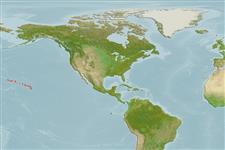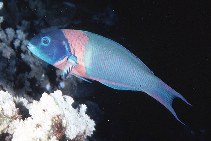Thalassoma duperrey (Quoy & Gaimard, 1824)
Saddle wrasse
Add your observation in Fish Watcher
| Native range |

|
| This map was computer-generated and has not yet been reviewed. |
| Thalassoma duperrey AquaMaps Data sources: GBIF OBIS |
Upload your photos and videos
Pictures | Videos | Google imageThalassoma duperrey
Picture by Randall, J.E.
Pictures | Videos | Google imageThalassoma duperrey
Picture by Randall, J.E.
Classification / Names Populärnamn | synonymer | Catalog of Fishes(Släkte, Arter) | ITIS | CoL | WoRMS | Cloffa
> Eupercaria/misc (Various families in series Eupercaria) > Labridae (Wrasses) > Corinae
Etymology: Thalassoma: Greek, thalassa = the sea + Greek, soma = body; the colour of the sea (Ref. 45335).
Eponymy: Captain Louis Isidore Duperrey (1786–1865) was a French naval officer (1802). [...] (Ref. 128868), visit book page.
More on authors: Quoy & Gaimard.
Etymology: Thalassoma: Greek, thalassa = the sea + Greek, soma = body; the colour of the sea (Ref. 45335).
Eponymy: Captain Louis Isidore Duperrey (1786–1865) was a French naval officer (1802). [...] (Ref. 128868), visit book page.
More on authors: Quoy & Gaimard.
Environment: milieu / climate zone / depth range / distribution range Ekologi
marina revassocierade; ej vandrande; djupintervall 1 - ? m (Ref. 58302), usually 5 - 25 m (Ref. 27115). Tropical; 22°C - 26°C (Ref. 27115); 30°N - 15°N
Utbredning Länder | FAO områden | Ekosystem | Förekomster | Point map | Utplanteringar | Faunafri
Eastern Central Pacific: Johnston (Ref. 11013) and Hawaiian islands.
Length at first maturity / Size / Vikt / Age
Short description Bestämningsnycklar | Morfologi | Morfometri
Body shape (shape guide): fusiform / normal.
Occur in clear lagoon and seaward reefs (Ref. 9710). Benthopelagic over coral, rock and rubble (Ref. 58302). Feed mainly on benthic animals. Juveniles and adults sometimes act as cleaners (Ref. 9710). Spawning occur either in aggregations by fish in the initial color phase or in pairs, typically with the terminal male being much larger than the female.
Life cycle and mating behavior Könsmognad | Reproduktion | Lek | Ägg | Fecundity | Larver
Pelagic spawner. Sex reversal is completed in 8-12 weeks (Ref. 34185, 34261). Also Ref. 38856, 38703. Primary males participate in group spawning and have large testes; secondary males engage in pair-spawning and have smaller, reduced testes (Ref. 48503).
Main reference
Upload your references | referenser | Koordinator : Westneat, Mark | Medarbetare
Randall, J.E., 1985. Guide to Hawaiian reef fishes. Harrowood Books, Newtown Square, PA 19073, USA. 74 p. (Ref. 3921)
CITES
Not Evaluated
Threat to humans
Harmless
Human uses
Fiskeri: kommersiell; Akvarium: Kommersiell
FAO - Publication: search | FishSource |
Ytterligare information
Population dynamics
Tillväxtparametrar
Max. ages / sizes
Length-weight rel.
Length-length rel.
Length-frequencies
Mass conversion
Rekrytering
Abundans
Tillväxtparametrar
Max. ages / sizes
Length-weight rel.
Length-length rel.
Length-frequencies
Mass conversion
Rekrytering
Abundans
Life cycle
Reproduktion
Könsmognad
Maturity/Gills rel.
Fecundity
Lek
Spawning aggregations
Ägg
Egg development
Larver
Larvdynamik
Reproduktion
Könsmognad
Maturity/Gills rel.
Fecundity
Lek
Spawning aggregations
Ägg
Egg development
Larver
Larvdynamik
Physiology
Body composition
Nutrients
Syreförbrukning
Swimming type
Simhastighet
Visual pigments
Fish sound
Diseases & Parasites
Toxicity (LC50s)
Body composition
Nutrients
Syreförbrukning
Swimming type
Simhastighet
Visual pigments
Fish sound
Diseases & Parasites
Toxicity (LC50s)
Genetics
Genetik
Heterozygosity
Ärftlighet
Genetik
Heterozygosity
Ärftlighet
Human related
Aquaculture systems
Vattenbruksprofiler
Avelslinjer
Ciguatera cases
Stamps, coins, misc.
Aquaculture systems
Vattenbruksprofiler
Avelslinjer
Ciguatera cases
Stamps, coins, misc.
Verktyg
Bio-Quiz | E-book | Fälthandbok | Längdfördelnings-verktyg | Livshistorie-verktyg | Prickkarta | Classification Tree
| Catch-MSY |
Special reports
Download XML
Internet-källor
AFORO (otoliths) | Aquatic Commons | BHL | Cloffa | BOLDSystems | Websites from users | Check FishWatcher | CISTI | Catalog of Fishes: Släkte, Arter | DiscoverLife | ECOTOX | FAO - Publication: search | Faunafri | Fishipedia | Fishtrace | GenBank: genome, nucleotide | GloBI | Google Books | Google Scholar | Google | IGFA World Record | MitoFish | Otolith Atlas of Taiwan Fishes | Offentliga akvarier | PubMed | Reef Life Survey | Socotra Atlas | Tree of Life | Wikipedia: Go, sök | World Records Freshwater Fishing | Zoological Record
Estimates based on models
Preferred temperature (Ref. 123201): 24.3 - 26.3, mean 25.1 °C (based on 60 cells).
Phylogenetic diversity index (Ref. 82804): PD50 = 0.5000 [Uniqueness, from 0.5 = low to 2.0 = high].
Bayesian length-weight: a=0.00851 (0.00471 - 0.01537), b=3.01 (2.86 - 3.16), in cm total length, based on LWR estimates for this species & Genus-body shape (Ref. 93245).
Trofisk nivå (Ref. 69278): 3.3 ±0.1 se; based on diet studies.
Resiliens (Ref. 120179): Hög, lägsta populationsfördubblingstid mindre än 15 månader (tm=1).
Fishing Vulnerability (Ref. 59153): Low vulnerability (18 of 100).
Nutrients (Ref. 124155): Calcium = 71.2 [43.3, 116.3] mg/100g; Iron = 0.751 [0.440, 1.322] mg/100g; Protein = 18.7 [15.8, 20.9] %; Omega3 = 0.145 [0.098, 0.222] g/100g; Selenium = 32.7 [20.8, 56.9] μg/100g; VitaminA = 71.8 [24.0, 258.1] μg/100g; Zinc = 1.46 [1.05, 2.27] mg/100g (wet weight);




